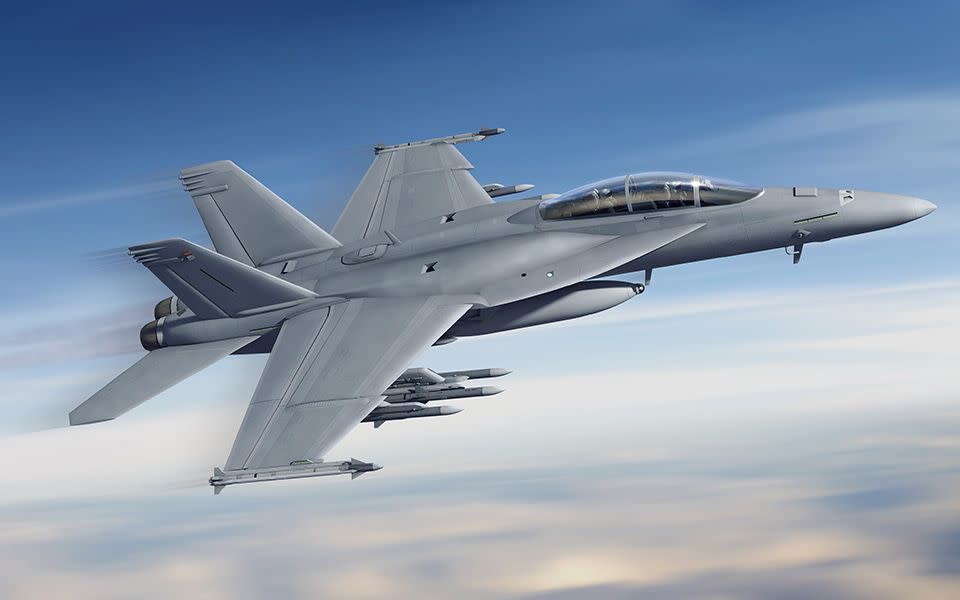The Navy Is Finally Creating America's Next Fighter Jet
The Navy wants a new fighter jet to replace Super Hornets starting in the 2030s.
The new fighter will be crewed and have a longer range than the F-35.
The Navy, faced with declining budgets through the 2020s and a short development cycle, may turn to a familiar face to get a “new jet” quickly.
The U.S. Navy is laying the groundwork to field a new fighter jet sometime in the next decade. The Next Generation Air Dominance fighter, meant to replace the F/A-18E/F Super Hornet, should start flying off America’s aircraft carriers in the 2030s. But a declining defense budget and short timetable could mean the best candidate is ... the F-35.
✈ You love badass planes. We love badass planes. Let's nerd out over them together.
U.S. Navy aircraft carriers typically embark four squadrons of fighter jets as part of the carrier air wing. Right now, all four squadrons fly the F/A-18E/F Super Hornet. Over the course of the next decade, the Navy will retire older Super Hornets in favor of the carrier-based variant of the F-35, the F-35C. By the 2030s, a carrier air wing should consist of about two squadrons of upgraded Super Hornets, the Block III, and two squadrons of F-35Cs.

The Navy wants a new fighter in the 2030s to replace Block III. Now, according to USNI News, the Navy has stood up the program to oversee development of the fighter, which it calls Next Generation Air Dominance (NGAD). The fighter would be the Pentagon’s first new fighter jet since the F-35.
The F-35 fighter jet took more than 20 years to take from blueprints to an operational fighter. During that time, the U.S. went from an era of relative peace as the sole unchallenged superpower to the present, where an aggressive Russia and surging Chinese military are emerging as strategic competitors.
From early on, the F-35 was locked into design choices that made sense in a period of non-competition, such as relatively short range, low supersonic speed, and a small internal weapons bay. If the Pentagon knew in the mid-1990s what it knows today, it might have asked for a vastly different airplane.
✓ The Next Steps
❏ See what the F-35 of the future will look like.
❏ Get more badass planes in your inbox.
❏ Dive deep into the best-in-class military and aviation features , and get unlimited access to Pop Mech.
The NGAD is a chance to build that airplane. The Navy wants a crewed fighter, as opposed to an uncrewed aerial vehicle. It also wants up to 50 percent greater range. A longer range will enable the NGAD to fight farther from the aircraft carrier, helping keep the big ship out of range of enemy weapons such as Chinese anti-ship ballistic missiles. The Navy needs an entirely new fighter, a so-called “clean sheet” design that isn’t a derivative of an existing aircraft. This would allow the Navy to build exactly the plane it wants.
What might an all-new NGAD look like? The aircraft could be a two engine, multi-role fighter, capable of tackling air-to-air and air-to-ground roles in the same mission. It would be stealthy, incorporating the latest radar-signature-reducing technology. It would almost certainly be a large plane, both to accommodate larger fuel tanks and a larger internal weapons bay.
While third- and fourth-generation fighters could easily extend their range and weapons load by hanging fuel tanks and munitions off the fuselage and wings, fifth- and sixth-generation fighters must carry both internally to preserve the airplane’s stealthy shaping. A newer fighter may have a shorter range and carry fewer weapons, but it’s a calculated tradeoff to ensure airplane and pilot will survive to fly more combat sorties.
While the Navy wants an all-new fighter, it’s not clear that will actually happen. Fifth-generation fighters, including the F-22, F-35, Russia’s Su-57, and the Chinese J-20 are immensely complicated machines that take a decade or more to develop. Already, experts believe the 2022 defense budget will be flat or suffer a 5 percent cut, depending on whether a Repubican or Democrat wins the White House.
The size of the federal budget deficit, and the impact of the COVID-19 pandemic on America's economy, will inevitably impact the U.S. defense budget throughout the 2020s. Time and budgetary pressures are beginning to stack up against the new plane.

As a result, the Navy might eventually be forced into accepting a derivative of the F-35.
A new adaptive cycle engine, currently under development, adds a third stream to the existing afterburning turbofan engine design, allowing a pilot to optimize the engine for high performance or long range. General Electric, which is developing an adaptive cycle engine for the F-35, believes the new engine will increase the jet’s range by 35 percent.
A partial redesign of the plane’s fuselage could increase the F-35’s internal fuel supply, allowing the new plane to reach the 50 percent range increase goal. An update of the F-35’s avionics, computer system, and perhaps even an onboard laser weapon would round out what might eventually be called the F-35D.
The prospect of a new American fighter jet is an exciting one, but expectations should be tempered against reality. Developing a new fighter is exponentially more difficult than it was a half century ago, and there might well be less money to do so than the Navy anticipates. On the bright side, it might finally be the opportunity to build a F-35 that satisfies everyone.
You Might Also Like


